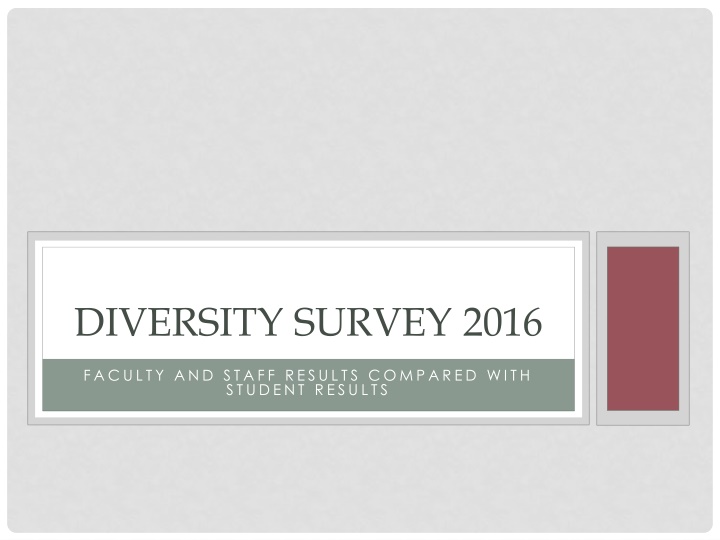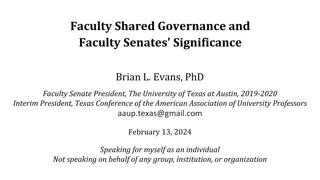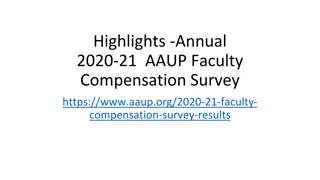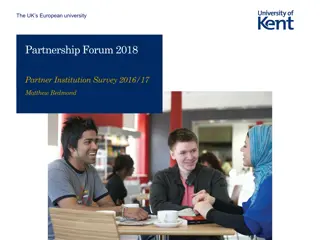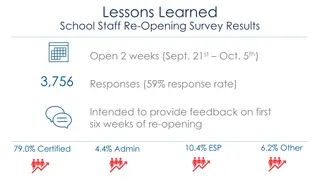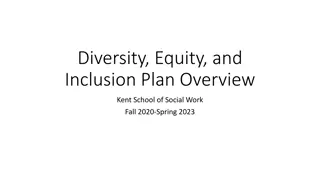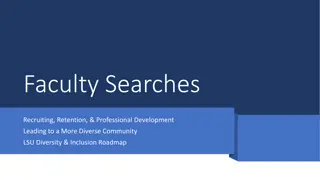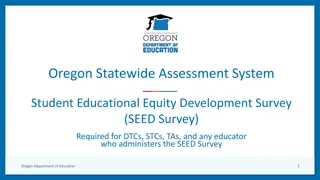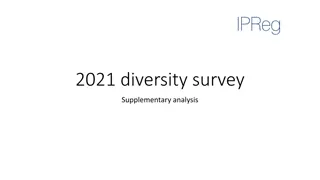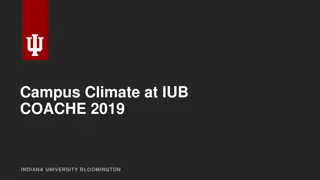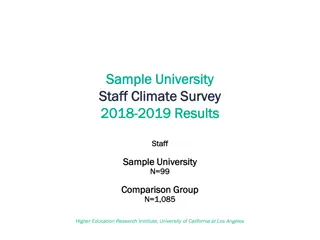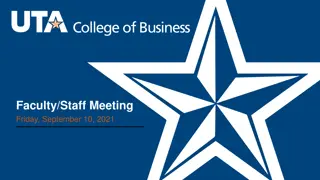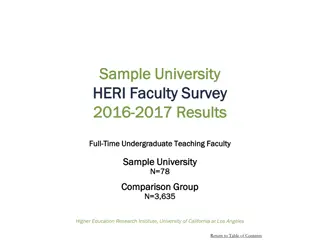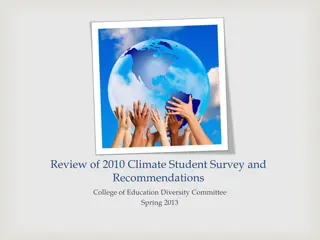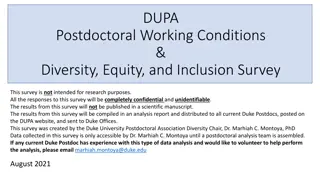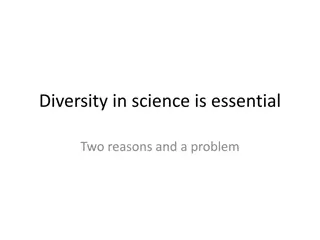Comparative Analysis of 2016 Faculty/Staff vs. Student Diversity Survey Results
Comparative analysis of the 2016 Faculty/Staff Diversity survey with student results to determine alignment and insights on diversity perceptions at Westmont. The faculty/staff survey was a companion tool to the student survey, providing information on institutional climate and possible future emphasis areas. Demographic data on years of employment, gender distribution, and racial identity was collected and analyzed.
Download Presentation

Please find below an Image/Link to download the presentation.
The content on the website is provided AS IS for your information and personal use only. It may not be sold, licensed, or shared on other websites without obtaining consent from the author.If you encounter any issues during the download, it is possible that the publisher has removed the file from their server.
You are allowed to download the files provided on this website for personal or commercial use, subject to the condition that they are used lawfully. All files are the property of their respective owners.
The content on the website is provided AS IS for your information and personal use only. It may not be sold, licensed, or shared on other websites without obtaining consent from the author.
E N D
Presentation Transcript
DIVERSITY SURVEY 2016 F A C U L TY A ND STA F F R ESU L TS C O M PA R ED WI TH STU D E NT R E SU L TS
SURVEY PURPOSE The main purpose of administering the Faculty/Staff Diversity survey was to determine whether Westmont faculty and staff see student diversity learning environments through the same lenses as students do. It is a companion tool to the Diversity Signature Assignment administered to students in Spring 2016 rather than a campus climate survey. Nevertheless, the Faculty/Staff Diversity survey results can provide us with some information about the institutional climate and assist us in identifying possible emphases for the future college climate if desired.
SURVEY BACKGROUND In Spring 2016, selected questions from the Diverse Learning Environments Survey (DLE), which captures student perceptions regarding the institutional climate and campus practices, were administered to Westmont students as an honor project conducted by Joseph Briones, a Kinesiology major. The DLE survey results provided the Diversity Assessment team with contextual information on student learning about diversity. The results helped the team to triangulate some direct assessment data collected through the Diversity Signature Assignment, which was administered in Spring 2016. All the student data used in this Powerpoint was gathered through the 2016 DLE Survey overseen by Joseph Briones.
FACULTY/STAFF SURVEY MAKE-UP The Faculty and Staff Diversity survey utilized the questions from Briones s version of the DLE survey and also included two questions concerning the Biblical and Theological Foundations of Diversity document, which are not part of the DLE. The survey consisted of 17 questions with one open- ended question regarding the Biblical and Theological Foundations of Diversity document. It was administered in November 2016 through the online survey tool Survey Monkey. Sixty-one faculty and 107 staff members responded to the survey.
DEMOGRAPHICS QUESTIONS 1-4
Q1: YEARS OF EMPLOYMENT AT WESTMONT 13% 20+ years 25% 21% 11-20 years 24% 32% 4-10 years 29% 34% Less than 4 22% Staff Faculty
Q2: GENDER 45% Male 36% 27% Faculty Staff Students(DLE) 55% Female 64% 73%
Q3: RACE IDENTITY 10% 25% Person of Color 33% 90% 75% White 67% Faculty Staff Students (DLE)
Q4: DO YOU IDENTIFY YOURSELF AS A PERSON OF COLOR? 10% 18% Yes 33% Faculty Staff Students (DLE) 90% 82% No 67%
Q5: I FEEL A SENSE OF BELONGING ON CAMPUS 85% Agree 89% 87% 15% Disagree 11% 13% Faculty Staff Students (DLE)
Q6: WESTMONT HAS A LONG STANDING COMMITMENT TO DIVERSITY 53% Agree 63% 57% 47% Disagree 37% 43% Faculty Staff Students (DLE)
Q7: WESTMONT PROMOTES THE APPRECIATION OF CULTURAL DIFFERENCES 81% Agree 82% 77% 19% Disagree 18% 23% Faculty Staff Students (DLE)
Q8: WESTMONT HAS ADMINISTRATORS WHO REGULARLY SPEAK ABOUT THE VALUE OF DIVERSITY 67% Agree 73% 69% 33% Disagree 27% 31% Faculty Staff Students (DLE)
Q9: WESTMONT HAS A LOT OF RACIAL TENSION 21% Agree 23% 38% 79% Disagree 77% 62% Faculty Staff Students (DLE)
Q10: HOW OFTEN AT WESTMONT HAVE YOU HEARD INSENSITIVE OR DISPARAGING REMARKS FROM STUDENTS? 59% 75% Never/Seldom 52% 41% 25% Affirm 48% Faculty Staff Students (DLE)
Q11: HOW OFTEN AT WESTMONT HAVE YOU HEARD INSENSITIVE OR DISPARAGING REMARKS FROM FACULTY/STAFF? 87% Never/Seldom 88% 91% 13% Affirm 12% 9% Faculty Staff Students (DLE)
Q12: SINCE JOINING WESTMONT, HOW OFTEN HAVE YOU ATTENDED PRESENTATIONS, PANELS, PERFORMANCES OR ART EXHIBITS ON DIVERSITY? 0% 1% I have attended all 27% 30% I have attended many Faculty Staff 68% I have attended a few 49% 5% I have not attended any 18% 0% 2% I am unaware of these
Q13: SINCE JOINING WESTMONT, HOW OFTEN HAVE YOU PARTICIPATED IN ON-GOING CAMPUS ORGANIZED DISCUSSIONS ON RACIAL/ETHNIC ISSUES? 0% 1% I have attended all 15% 26% 24% I have attended many 16% 55% I have attended a few 39% 30% 19% I have not attended any 34% 30% 0% I am unaware of these programs 2% 9% Faculty Staff Students (DLE)
Q14: STAFF MEMBERS HERE ARE WILLING TO TALK ABOUT EQUITY, INJUSTICE, AND GROUP DIFFERENCES. 5% Very Often 5% 44% Often 33% Faculty Staff 30% Sometimes 40% 12% Seldom 22% 0% Never 0%
Q15 & 16: BIBLICAL AND THEOLOGICAL FOUNDATIONS OF DIVERSITY DOCUMENT Yes, I know where it is 51% 54% No, I don't know where it is 49% 46% Faculty Staff Yes, it impacts my work 33% 36% No, it doesn't impact my work 67% 64%
Q17: IF YES, HOW DOES THE BIBLICAL AND THEOLOGICAL FOUNDATIONS OF DIVERSITY DOCUMENT IMPACT YOUR WORK? Faculty (n=20) Helps to make pedagogical or curricular decisions 45% Impacts or resonates with personal values 35% Serves as Department/Division priority 10% Helps with interpersonal interactions with students 10% Non-responsive critique 10%
Q17: IF YES, HOW DOES THE BIBLICAL AND THEOLOGICAL FOUNDATIONS OF DIVERSITY DOCUMENT IMPACT YOUR WORK? Staff (n=33) Impacts or resonates with personal values Provides institutional context/framework 33% 24% Interferes with work 15% Helps with interpersonal interactions with students 15% Helps to make curricular decisions 3% Non-responsive answers 12%
